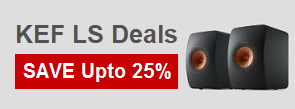Product Video
Features
| Frequency Response | 59Hz – 28kHz |
|---|---|
| Removable Grill | Yes |
| Warranty length | 2 Years |
| Brand | Focal JM Labs |
Tech Specs
- Type: 2-way closed centre speaker
- Speaker drivers: 2x 6 1/2" (16.5cm) slate fiber Midrange/Bass 1" (25mm) Al/Mg inverted dome TNF tweeter
- Sensitivity: 91dB
- Bandwidth: 59Hz – 28kHz
- Low-frequency cut-off: 51Hz
- Nominal impedance: 8Ω
- Minimal impedance: 3.8 Ω
- Recommended amp power: 40 – 200W
- Crossover frequency: 2100Hz
- Dimensions (HxWxD): 83/8"x207/8"x101/4" (21.2x53x26cm)
- Net weight (with grille): 22.05lbs (10kg)
- Box dimensions (HxWxD): 125/8"x243/8"x153/8" (32x62x39cm)
- Net weight (with packaging): 26.46lbs (12kg)
Product Description
Focal Theva CC centre speaker is designed to complement the rest of the Theva range. It's a two-way speaker with two Slatefibre bass/midrange drivers, and the renowned inverted dome tweeter.
This centre speaker is designed to deliver dialogue that is clear and detailed. It is easy to place, an elegant addition to any décor. A stand is available separately or the speaker can be placed on a piece of furniture.
The design is delicate with a touch of French style. Notably, there are black or wood finishes, and the driver rings are made of metal. Finally, there is a rear-firing bass port for enhanced low frequency response.
Inverted dome tweeter
The focal developed, inverted dome tweeter, generates well dispersed high frequencies. This makes speaker placement less critical. Additionally, the lightweight bonded voice coil makes the tweeter easier to drive. The result is a clean and precise treble. This new tweeter demonstrates Focal’s commitment to new methods and materials, as do the Slatefibre bass units.
High performing carbon fibre bass drivers
Carbon fibre is a very light and rigid material, making it ideal for low mass speaker cones. This benchmark design spent many years in development before being released. The sound is rich and ultra-balanced with a clear and precise midrange. Distortion is also reduced.
Non woven carbon fibre cones
Recycled, non woven carbon fibres are used to make the driver cones. These are mixed into a thermoplastic compound. The result is a material that is very light and strong. Additionally, the material resists warping, making distortion less at high volumes. Moreover, the improved rigidity and damping make the sound controlled and punchy. Notably, carbon fibre is five times stronger than steel and twice as stiff.
Carbon fibre ideal cone material
Carbon fibre is both light and strong making it the ideal speaker cone material. Several factors demonstrate this. The first is rigidity. The carbon fibres are all oriented in the same direction. This moves air with more accuracy, even at high volumes. Next is damping, carbon fibres resist the tendency to keep vibrating when the sound stops. Finally, Lightness makes the cones easier to drive.
Why a centre speaker?
Most films are mixed with a centre dialogue channel. Therefore, without a centre speaker, dialogue can be difficult to hear. In fact centre channels have been around since 1940, when Disney’s Fantasia was released. This film has a stereo soundtrack, as well as a centre channel. Moreover, even basic AV amplifiers will have a centre channel output. There is also the issue of levels. With a centre speaker, you can boost the dialogue without affecting the rest of the sound.
Why ported speakers?
Ported speakers have a port that allows the air inside the enclosure to expand. This improves the low frequency response. The port can be placed either on the front or the rear, depending on the size of the enclosure. Notably, subwoofers have a bass port on the bottom, that fires at the floor. This is useful for earthquakes in movies. Sealed cabinet speakers are available, but they require more amplifier power, for a given bass output. As a result, they often feature digital signal processing to boost the bass.
Who are Focal?
Focal was founded in 1979 and its core business is speaker drivers and high-performing loudspeakers. Their ethos is the union of technology, mechanics, advanced materials and design. Innovation is coupled with design, to provide the best audio experience. New materials such as carbon fibre, push the limits of what can be achieved in audio reproduction.











































































